Research Article
Volume 2 Issue 6 - 2018
Monitoring of A Cacao Fruit Infected with Frosty Pod Rot (Moniliophthora Roreri) (CIF. & PAR.) Evans et al attached to the Tree
Agronomist Engineer Carrera 86 #34-56, Medellín, Colombia
*Corresponding Author: Gabriel Cubillos, Agronomist Engineer Carrera 86 #34-56, Medellín, Colombia.
Received: November 30, 2017; Published: June 02, 2018
Abstract
The cacao pods affected by Frosty Pod Rot (Moniliophthora roreri) hanging on the trees are the main source of infection because they trigger the epidemic episodes. As a consequence, it was considered important to know the critical state of the diseased pods during which they turn into authentic infection sources. To achieve this, it was necessary to observe the changes suffered by one infected pod during seven weeks, from its initial stage characterized of brown stains. The results indicate that the pod reached sporulation in one week and kept its full potential for three. It started losing sporulation power by the seven week, when it showed thin spore lumps only in some places. In order to break the epidemic episodes the cultural control must be especially focused on the removal of pods with brown stains and early sporulation stages.
Keywords: Frosty Pod Rot; Cacao; Pods; Cultural Control; Infection
Introduction
Within the cultural control platform it’s fundamental to know the infection power of the pods affected by Moniliophthora roreri (Ciferri & Parodi) Evans., et al. still attached to cacao trees. To do so is necessary to trace the evolution and determine the critic period that they constitute infection sources within the crops.
Materials and Methods
At the Granja Agrícola La Nacional, in the Támesis municipality (Antioquia department), Colombia, SA., located 1040 meters above the sea level, with an average temperature of 23°C, 2300 millimeters of annual rain and 76% of relative humidity, on July 15th 2017, a pod in brown-stain stage (Figure 1), still attached to the tree (clone ICS-39) was chosen in order to monitor the evolution of symptoms and sporulation process. The pod was periodically checked during seven weeks.
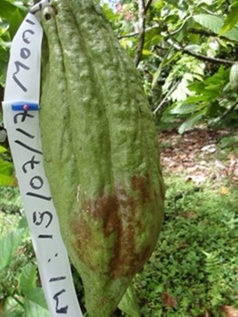
Figure 1: Pod with M. roreri in brown stain stage (clone ICS-39).
Granja La Nacional, Támesis municipality, Colombia SA.
Results
Seven days after the beginning of the monitoring process (July 22nd) the pod was found sporulated (Figure 2). The white pseudostrome covered all the stain and the formation of cream-colored spore lumps was observed in different places. It was from this moment on, that the diseased pod became a powerful source of infection
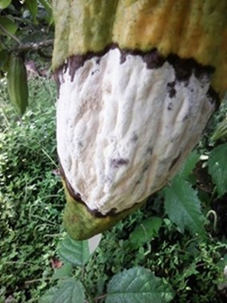
Figure 2: Pod of the clone ICS-39, seven days after that was observed in brown stain state. Granja La Nacional, Támesis municipality, Colombia SA.
On July 26th, eleven days later, the pod was found completely covered of cream-colored spores (ripes) ready to be spread especially by the wind Figure 3.
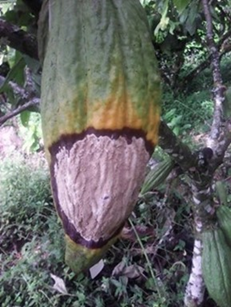
Figure 3: Sporulated pod eleven days after its original brown stain stage. Granja La Nacional, Támesis municipality, Colombia SA.
On July 29th, two weeks later, (one week after the beginning of the sporulation process) the pod evidenced maximum sporulation which was distributed on all its surface showing lumps of ripe cream-colored spores already detaching from the mycelium. Figure 4.
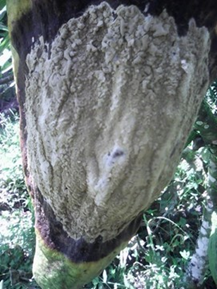
Figure 4: Sporulation of the pod one week after the beginning of the sporulation process. Granja La Nacional, Támesis municipality, Colombia SA.
On August 5th, two weeks after the beginning the sporulation process, the pod is still intact with spreading cream-colored spore lumps; similarly to the previous week Figure 5. This means after beginning the sporulation process and during two weeks the pod apparently keeps its infective power.
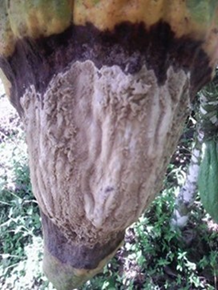
Figure 5: Sporulation stage of the pod two weeks after the beginning the sporulation process. Granja La Nacional, Támesis municipality, Colombia SA.
On August 12th, three weeks later, the pod keeps its sporulation but not with the exuberance of the previous week. Figure 6. A significative portion of the mycelium is showing a greyish color.
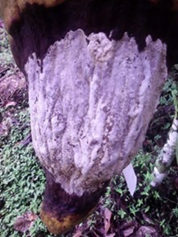
Figure 6: Pod in stain stage after three weeks of sporulation. Granja La Nacional Támesis municipality, Colombia SA.
On September 9th, the pod has been sporulating for seven weeks. Yet it can be observed how sporulation power has been lost after being reduced to thin lumps in disperse areas. The mycelium follows taking the greyish color, Figure 7.
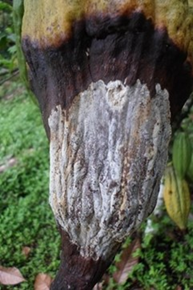
Figure 7: State of the pod seven weeks in sporulation stage. Granja La Nacional, Támesis municipality, Colombia SA.
Discussion and Conclusions
The pods with Moniliophthora roreri in brown (chocolate-colored) stain stage normally begin to sporulate seven days later. From the first week the sporulation is profuse and they become powerful sources of secondary infection, generating heavy epidemic episodes that could take up to two additional weeks. Later, they lose great part of the sporulation power and behaving like primary inoculum (perpetuating the disease within the crop) as it was observed after seven weeks of monitoring. Cultural control of Frosty Pod Rot essentially involves detachment of the affected pods (chocolate-stained stage) from the cacao trees and also those which sporulated recently. These pods can be freely left on the ground as the easiest measure to interrupt the epidemic cycle of the disease, according to the statements of González (1983) and Cubillos (2017) who say that under these conditions they cannot generate new infections.
Acknowledgments
The author thanks to all people that helped to register the photographic scenes. Especially to the staff of the Granja Agrícola La Nacional of Compañía Nacional de Chocolates (Nutresa Group). Of course, to Professor David Hernández who reviewed the English version.
The author thanks to all people that helped to register the photographic scenes. Especially to the staff of the Granja Agrícola La Nacional of Compañía Nacional de Chocolates (Nutresa Group). Of course, to Professor David Hernández who reviewed the English version.
References
- Cubillos G. “Cocoa Pod and Pod Borer: enemies that damage cocoa crops in Colombia”. Lambert Academic Publishing (2017): 43.
- Gonzáles LC. “Proyecto de investigación. Epifitiología y combate de la Moniliasis del cacao. Informe anual 1981”. El Cacaotero Colombiano 23 (1983): 40-53.
Citation:
Gabriel Cubillos. “Monitoring of A Cacao Fruit Infected with Frosty Pod Rot (Moniliophthora Roreri) (CIF. & PAR.) Evans et al
attached to the Tree”. Innovative Techniques in Agriculture 2.6 (2018): 509-513.
Copyright: © 2018 Gabriel Cubillos. This is an open-access article distributed under the terms of the Creative Commons Attribution License, which permits unrestricted use, distribution, and reproduction in any medium, provided the original author and source are credited.





























 Scientia Ricerca is licensed and content of this site is available under a Creative Commons Attribution 4.0 International License.
Scientia Ricerca is licensed and content of this site is available under a Creative Commons Attribution 4.0 International License.